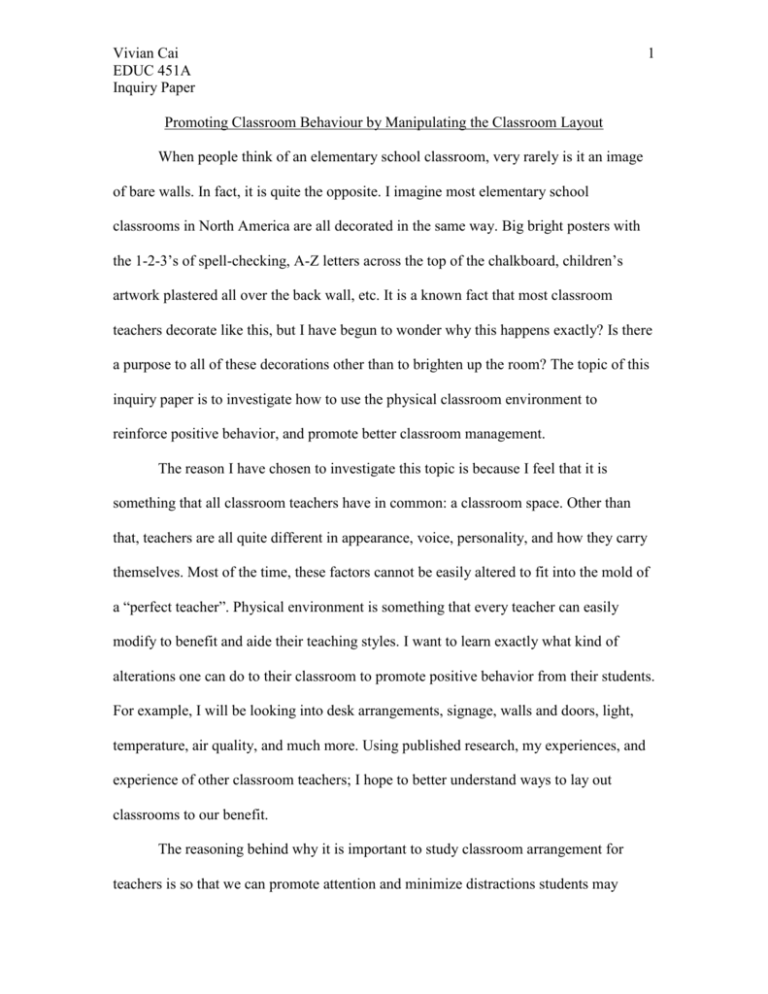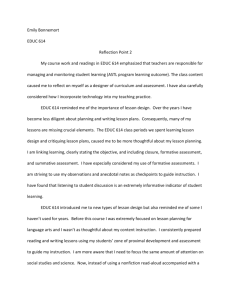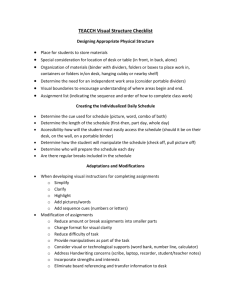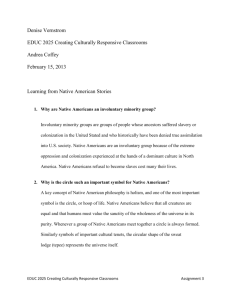Promoting Classroom Behaviour by Manipulating the
advertisement

Vivian Cai EDUC 451A Inquiry Paper 1 Promoting Classroom Behaviour by Manipulating the Classroom Layout When people think of an elementary school classroom, very rarely is it an image of bare walls. In fact, it is quite the opposite. I imagine most elementary school classrooms in North America are all decorated in the same way. Big bright posters with the 1-2-3’s of spell-checking, A-Z letters across the top of the chalkboard, children’s artwork plastered all over the back wall, etc. It is a known fact that most classroom teachers decorate like this, but I have begun to wonder why this happens exactly? Is there a purpose to all of these decorations other than to brighten up the room? The topic of this inquiry paper is to investigate how to use the physical classroom environment to reinforce positive behavior, and promote better classroom management. The reason I have chosen to investigate this topic is because I feel that it is something that all classroom teachers have in common: a classroom space. Other than that, teachers are all quite different in appearance, voice, personality, and how they carry themselves. Most of the time, these factors cannot be easily altered to fit into the mold of a “perfect teacher”. Physical environment is something that every teacher can easily modify to benefit and aide their teaching styles. I want to learn exactly what kind of alterations one can do to their classroom to promote positive behavior from their students. For example, I will be looking into desk arrangements, signage, walls and doors, light, temperature, air quality, and much more. Using published research, my experiences, and experience of other classroom teachers; I hope to better understand ways to lay out classrooms to our benefit. The reasoning behind why it is important to study classroom arrangement for teachers is so that we can promote attention and minimize distractions students may Vivian Cai EDUC 451A Inquiry Paper 2 encounter that interfere with learning. By creating an effective classroom space, students will have easier access to materials, movement will be orderly, and traffic of the classroom will be controlled. There is no one-rule giving complete direction as to how to set up the perfect classroom, but at minimum, the space should accommodate multiple configurations for large and small groups, for triads, pairs, and individuals to talk, listen, write, read, play, and learn (Faulk & Evershen, 2013, p.41). There will of course be constraints in classroom size and shape; there is no cookie-cutter classroom physical design. Thus, there is only one approach to accommodate physical space while supporting learning goals: flexibility. In my opinion, learning spaces need to be seen as flexible, not fixed. Teachers must be open to minor changes such as moving furniture around and changing location of materials. Although it may require some more work before and after school, I believe it will benefit in the long run if it means minimizing disruptive behavior in the classroom during school hours. From the research I have read, and conversations I’ve had with other teachers, the biggest thing I’ve learned about desk arrangements is that you must know your students well in order to know where they will work best (Rimm-Kaufman et al., 2005, p.378). There are many ways to change up the desks of a classroom: tradition ways such as rows where students sit alone, rows where students are in pairs or groups, clusters, u-shapes, semicircles, circles… the list goes on. In my practicum classroom, it is a variety of these arrangements. Right now, we have students in rows with groupings of three, and two clusters because we have two large tables instead of eight more individual desks. Previously, we have had u-shapes: one small one and one larger, with the large tables behind everyone else. I pointed out to my sponsor teacher that this wasn’t working well Vivian Cai EDUC 451A Inquiry Paper 3 because the way the large tables were designed meant that two students at each table had their backs facing the front. We were able to figure out a way to move them to the side of the desk area so that all four students were facing sideways. It is much easier to turn to the front that way rather than having to turn an entire 180° and not have a hard surface to write on. My SA likes to give choice once in awhile to students in terms of who they can sit beside; occasionally during desk changes, she lets them choose one other person they would like to sit beside and she arranges the desks to accommodate. I’m not entirely sure I would do that when I have my own classroom; but each class dynamic is different. We often hear the saying “we teach the way we learn”, and I think I am the type of teacher who is slightly more old-fashioned because that’s how I have been taught in my school experience; I would probably start the year off with students in pairs and arrange desks in rows. If individual work needs to be done, students can shift over slightly so that they are sitting alone. If group work needs to be done, two students can turn around to the two students behind them. This is a flexible, yet task appropriate desk arrangement that will benefit both the students and teacher. From what I have read, students tend to display higher levels of appropriate behavior during individual tasks when they are seated in rows, with disruptive students benefiting the most (Wannarka & Ruhl, 2008, p.89). Disruptive students and chatty students also benefit from sitting closer to the front (Wannarka & Ruhl, 2008, p.90). The issue I have realized from being in a grade 4 class is that some students are beginning to develop difficulties seeing the board from the back of the room and have not yet had their eyes checked for glasses. Many of these students are the best behaved of the class but need to sit in the desks near the front due to sight issues. This is something that I might Vivian Cai EDUC 451A Inquiry Paper 4 raise as an issue to my SA to discuss with parents. But this all comes back to knowing your students well. Who can see the board and who can’t? Who gets along and who doesn’t? Which well-behaved student might positively influence a disruptive student by sitting next to them? Is it a good idea to put the pair of girls who like to chat and gossip close to each other? I believe teachers need to know the answer to all of these questions in order to determine a beneficial seating arrangement. I believe that the positioning of the “throne” is also very important. A teacher’s desk greatly influences traffic of the room. Students frequently walking back and forth to ask questions, speak to you, get materials, etc. Students who are easily distracted may not benefit from sitting close to the teacher’s desk although it may have seemed like a good idea at the time because you are able to supervise them closer from your desk. Other congested areas could also include: the pencil sharpener, garbage cans, sink, and computer stations. I also wonder if the location of the teacher’s desk might get in the way during highly congested times such as when students come in/leave in the morning and after school, handing in work all at once, etc. In my practicum classroom, the teacher’s desk is facing the wall at the back corner of the room. It is close to the group-work station and the area sometimes becomes very congested when the teacher is sitting in her chair. Also, the teacher will not be able to see the class if she is sitting at her desk because she is facing the wall, and a bookshelf closes her side off to the rest of the class. I believe that with some heavy lifting, it is possible to move the desk to a more appropriate and resourceful area of the classroom. However, I will probably keep that project for myself when I have my own classroom one day. Vivian Cai EDUC 451A Inquiry Paper 5 Surprisingly, signage is also a factor that can affect classroom behavior in positive and negative ways. Bare walls with no decoration may lead to students feeling bored and unmotivated to learn, while walls plastered in colourful posters and student’s art might be over stimulating causing students to be easily distracted during class (Faulk & Evanshen, 2013, p.42). It is important to find a good balance when decorating the classroom. Of course, visual appeal is helpful, but it also depends on several key strategies, such as creating clear uncluttered displays and providing proper signage with a consistent pack of print, font, size, and color scheme (Roskos & Neuman, 2011, p.112). Using graphics to enhance ideas is important in terms of what kind of attention you hope to capture through signage. Other than posters, displaying student work is also an art in itself. Although it may be time consuming, I believe that only current student work should be displayed because it is what they are proud of currently. Seasonal artwork should be sent home with the season as it ends. Posters made at the beginning of the year are not something students are thinking about because they have created many other projects which they have on their minds; it is merely clutter if old work continues to be hung on the walls – similar to the idea of keeping outdated and faded posters up. I have not been in tons of elementary schools so I cannot say I have seen sufficient evidence, but from what I have seen, very few classrooms have met the criteria discussed above in terms of signage. Often times I see posters taped up slanted, some posters contradict others, and most are faded and very outdated. You know it’s time to change the ABC’s above the chalkboard when V still stands for videotape. The same goes for outdated maps, currency posters with Pennies, and planet posters with Pluto still included. I’m not an interior designer, so I asked my friend who recently graduated from Vivian Cai EDUC 451A Inquiry Paper 6 BCIT’s interior design program for some tips on decorating one large space. She advised me that each wall should have one main piece that captures attention, and this piece should be easy to point out. The surrounding decorations should lend attention to and focus on the main piece. The wall should also be color coordinated so that your brain can focus on the text rather than be distracted by processing too many colours. I imagine it is the same idea as choosing the right textbook for your class. Are there so many illustrations on a page that my eyes don’t know where to look or even start? Then it’s probably too over stimulating (Cho et al., 2013, p. 166). Many teachers blog about their classroom space and how they have setup their signage. The ones that have stood out to me visually have been ones that are uncluttered, colour coordinated, aesthetically pleasing, and are categorized from wall to wall. Placement of classroom material is something that can also influence traffic within the class, which in turn can cause unnecessary disruptions. When materials such as books, stationary, and supplies are artfully and intentionally arranged, they invite and motivate students to engage productively with the material (Roskos & Neuman, 2011, p.112). Messy, cluttered, and random organization of materials in the classroom environment does quite the opposite of this, but interestingly enough many classrooms are still set up in such a manner. Materials need to be easily accessible and within the students’ reach both physically and conceptually (Roskos & Neuman, 2011, p.112). Important and commonly used items should be placed at eye and hand level so students can easily see and grab. There also needs to be a sufficient amount of materials within a classroom in order to minimize disruption – research shows that a classroom should have 5-8 books per student of various kinds (Roskos & Neuman, 2011, p.111). Vivian Cai EDUC 451A Inquiry Paper 7 In my opinion, materials should be grouped together so that it makes sense. Many classrooms I have been in have boxes of markers in one area of the room, sharpies in the opposite corner, and glue sticks and scissors somewhere else. If a student or a group of students are working on a poster project, they will have to walk to one side of the room for markers, the other side for sharpies, and retrieve glue sticks and scissors somewhere else. If all art supplies were stored in one area, this entire gathering of supplies could be resolved in one trip. Another method of minimizing distractive movement is having a basket of art supplies per table group so that groups of students can easily access these materials and share with one another. There are so many factors that contribute to the variety of student behaviour we see in our classrooms. The teaching field is trending towards more partner and collaborative work and having an area in your class where this can be done is important. However, this also means more background noise and more management issues to take care of. If possible, altering the physical environment of your classroom can help students’ concentration and attention levels. Roskos and Neuman (2011, p.113) put emphasis on “greening” the classroom environment. Light, temperature, air quality, crowding, and noise are all elements that affect the instructional process. The authors suggest maximizing exposure of natural lighting as much as possible, using less toxic cleaning agents, using sound absorbing materials to decrease background noise levels, vary air temperature for quiet and physically active tasks (Roskos and Neuman, 2011, p.113), etc. Some of these factors may be out of the teachers control, but if altering the “invisible” environment will lead to a better, healthier, classroom life for children, I would definitely want to try it out. Vivian Cai EDUC 451A Inquiry Paper 8 Prior to writing this paper, I thought I would have great epiphanies from reading the research based on this subject and would know the exact right method to set up a classroom. Turns out, I didn’t. Instead, I realized that most of the theories and concepts regarding classroom setup is generally common sense. The hardest part is putting it all together and physically moving your classroom around – sometimes having to flip it upside down – in order to help the class increase positive behaviour. Some teachers might think it’s not worth it, others might think it’s just too hard, but from the amount of research that exists on this topic, it is evident that people do care about classroom layouts. Much of the research I have looked at for this paper studied primary classroom environments. I would like to continue to investigate several other issues that deal with classroom layout, especially the differences in classroom setup needs in primary and intermediate classrooms. There are different teacher goals and outcomes between primary and intermediate, and I’m quite sure there are differences in needs because in primary grades, classroom management is a bigger issue while academic learning is not stressed as much. The case is opposite when students get to intermediate grades when parents begin to care more about letter grades and report cards. Further down the road when students get to high school, college, and university, less emphasis is placed on how a learning environment is setup. Lecture halls and tutorial rooms are usually completely bare. So how do the needs of different grades and ages relate to setting up the classroom? It would be interesting to do some further research on this topic. We aren’t interior designers, we are teachers; but yet we have the job of creating a work environment that is suitable for 30 different students while accommodating the size and space we are given and budget limitations. It would be great if there were teams of Vivian Cai EDUC 451A Inquiry Paper 9 interior designers who specialized in classroom design to come into classes and tear things down/put things up and make it perfect, but unfortunately I cannot see this happening in the near future. Importance has not yet been placed on classroom setup and I am unsure if it will be mainly due to limited budgets the school district has. There are many other things I can think of in which they would rather disperse money to, and I do not disagree. Although I don’t think classroom setup is first priority when it comes to classroom management, I do believe it should be considered when teachers set up their classroom at the beginning of the year. Even though we may not be able to design our classrooms down to perfection, a little bit here and a little bit there will make small differences that eventually add up to a better classroom environment. Vivian Cai EDUC 451A Inquiry Paper 10 References Cho, Y., Chung, H., Choi, K., Seo, C., & Baek, E. (2013). The Emergence of Student Creativity in Classroom Settings: A Case Study of Elementary Schools in Korea. Journal of Creative Behavior, 47(2), 152-169. Faulk, J., & Evanshen, P. (2013). Linking the Primary Classroom Environment to Learning. YC: Young Children, 68(4), 40-45. Rimm-Kaufman, S.E., La Paro, K.M., Downer, J.T., & Pianta, R.C. (2005). The Contribution of Classroom Setting and Quality of Instruction to Children’s Behavior in Kindergarten Classrooms. Elementary School Journal, 105(4), 377394. Roskos, K., & Neuman, S.B. (2011). The Classroom Environment: First, Last, and Always. The Reading Teacher, 65(2), 110-114. Wannarka, R., & Ruhl, K. (2008). Seating Arrangements that Promote Positive Academic and Behavioural Outcomes: A Review of Empirical Research. Support for Learning, 23(2), 89-93.







